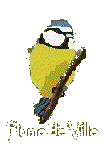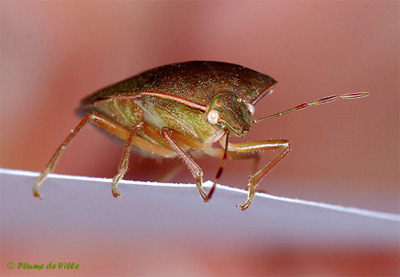Plume de Ville
From day to day.
November 2009
November 2nd
To forget a bit the autumn ... summer butterflies (1).
Silver-washed Fritillary [Argynnis paphia
-Nymphalidae Argynnis-] (Tabac d'Espagne)
It
is found
throughout Europe. Likes brambles, forest, its host plant is the violet.
Male
and
female are bright orange with black spots.
The black lines on top of wings are present only in males. As here.
Only one generation per year. Larvae hatch in late autumn, will make a
shelter
and hibernate until March.
(110609-300709)
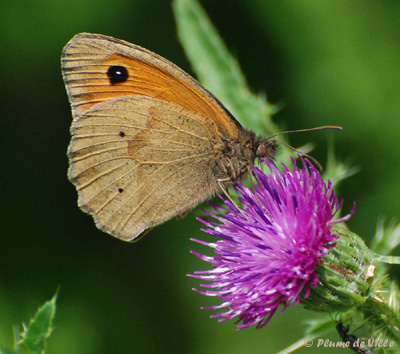 Meadow
Brown.
[Maniola
jurtina - Nymphalidae Satyrinae] (Myrtil)
Meadow
Brown.
[Maniola
jurtina - Nymphalidae Satyrinae] (Myrtil)
Underside is orange for this great fan of mallow and violet.
Forest edges, meadows.
Male.
(40-48mm)
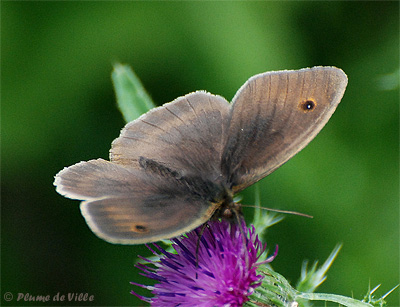
The upside
of wings of the male is dark and brown.
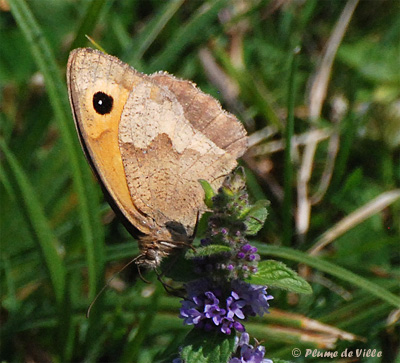
The female
usually has a large white band in the hind wings, with an undulating
contour.
The black dots are highly variable and may be more or less present.
Smaller ocellus
for the male and wavy outline barely visible.
(110609)
November 3rd
Summer butterflies (2).
Speckled
Yellow [Pseudopanthera macularia-Geometridae
Ennominae-]
(Panthère)
A small diurnal moth. Observed
from April to June. Only one generation per year.
Dressed all in yellow and dotted with panther spots of shape and size
depending
on the regions, and shades lighter or darker.
(3cm)
(200509)
Mallow Skipper. [Carcharodus
alceae-Hesperiidae Pyrginae-] (Grisette)
Small
transparent spots on the forewing.
Brown, grey and yellow with a complicated set of dark spots. Diurnal.
He loves lavatera and mallow. Its host plant is the mallow.
(3cm) (April-august)
(300709)
November 4th
Blackcap.
Blackcap.
[Sylvia atricapilla-Passeriformes Sylviidae-]
(Fauvette à tête noire)
The Blackcap has a... tawny-brown head in females. The black head is
restricted
to males.
Gray yellow underside.
In autumn they feed on berries and fruits.
A virtuoso singer, but in autumn it is rather quiet.
(Patis 291009)
Met
in late
October, in the undergrowth, the female blackcap is almost invisible.
Very vivid,
it permanently switches from branch to branch, jumping from here to
there,
always remaining under cover. Hard to photograph through the branches.
Young (below)
is very similar to females. The cap is brown. If you could fail
to see this youngster perched almost at the ground level in a thicket,
you
could not miss its incessant nagging call.
Vincennes 130807
The
male
and its black cap well down right to its eyes like a little hat well
down.
It is here spring dressed and for once a little less undercover.
Delicate pale grey neck and abdomen, brownish grey back, slate grey
beak and grey
legs.
Some individuals migrate in winter, especially those of northern and
north-east
(known as partially migratory) but some still spend the winter there.
(Sceaux 240408 )
November 5th
Pretty
little moth.
In purple and gold, it flights day and night in two annual generations.
(2cm)
At first I had mistaken it for a Pyrausta purpuralis, (pryrale pourpre).
But the yellow markings of the forewings of the Pyrausta purpuralis are usually three and form a broad band that can be almost continuous. In the mint moth, we see on the wing mostly a round yellow spot near the edge of the wing and a much smaller spot between it and the edge of the wing.
(200509)
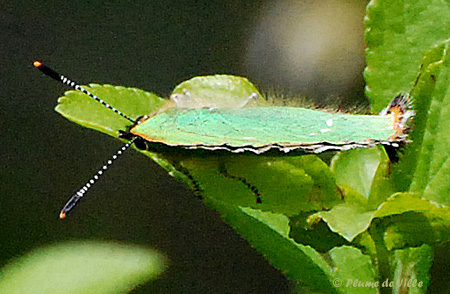 Green
Hairstreak.
[Rubi-Callophrys Lycaenidae Theclinae-]
Green
Hairstreak.
[Rubi-Callophrys Lycaenidae Theclinae-]
(Argus vert, Thécla
de la ronce)
It gave me hard times this very small green. And I have not succeeded
to catch
its wings properly.
Each time when I was finally ready to take the picture after a long
pursuit, it
took perverse pleasure to turn instantly on the side, as if it has
heard the camera
trigger! It was enough high placed and cannot be taken from above and
it did
not stand in the same place long enough.
Yet it is exceptionally beautiful with very special reflections,
delicately
green and changing. It is very difficult to spot as it blends easily
into the
vegetation.
His
eyes
are rimmed with white. The upper side is brown but it rarely hold its
wings open.
Perhaps it will be for next time...
(25mm) (210409)
November 6th
Bug!
Not
very
much loved, yet they deserve attention.
This
bug has taken a shower at the same time as the orchid (a Masdevallia)
where it thought it had found a warm indoors shelter for the winter.
I can assure
you that she hates the water and fled to the tip of leaves to
avoid the flood, wearing here coquettishly a little hat (which it
gladly would
do without, I think).
A quick tissue touch later, here it is, more visible.
It is a green bug. Yes, yes. During the winter the all green bug becomes brown and very brown.
The
squatter of my orchid is in between, a little green but darkening.
Three white spots on the scutellum (the triangular part of his back) with two small black dots at the corners of the latter tell the specialists.
So
I think here it is Nezara viridula, the southern green stink
bug. [Heteroptera,
Pentatomides] (Punaisse verte).
Still
me!
With my aspect a bit "Alien", in this view.
No
I don't have red eyes!
My eyes are the two ping-pong balls on each side.
Indeed: if you look at
me in the eyes?
I know I'm part of the group "stink bugs", my defence is my foul odour
but do not generalize! Some bugs are ... fragrant and with apple smell.
And if it does not bother me I do not use my weapon.
Despite its kindness at posing, I still invited it to overwinter
outside the
home.
(15mm)
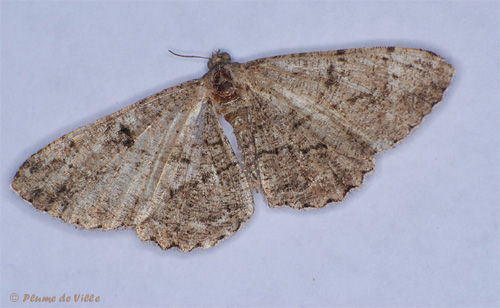
And
since
I'm with the inhabitants of the house which, as the weather become
cooler, invited
themselves to shelter. Here is a small butterfly.
Willow Beauty. [Peribatodes
rhomboidaria-Geometridae Ennominae-] (Boarmie
commune, Boarmie rhomboïdale)
Widely this little geometridae can take multiple forms, even black.
It's a
moth, a moth that has come to end his life between two library books.
(40mm)
9 novembre
Summer butterflies (4).
Sylvain et sylvaine.
Large
Skipper.
[Ochlodes Venatus (= Ochlodes faunus, Augiades sylvanus)-Hesperiidae
Hesperiinae-] (Sylvaine.)
Alighted
in the characteristic way of Hesperia, wings not folded against one
another, slightly inclined.
The
black mark on the wing is the male androconial streak formed by
odoriferous
scales (attractive pheromone).
(120609)
They
are
"big heads" with a very fast fly.
Antenna clubbed with a curious terminal hook.
It favours open areas like meadows. Common butterfly, largely
widespread; the
large skipper is found almost everywhere.
(25-30mm)
White
admiral.
[Limenitis camilla (= Ladoga camilla)-Nymphalidae Limenitinae-]
(Petit sylvain.)
Likes
moist and shaded areas.
It
is often found in the woods and bushes growing along a watercourse.
(50mm)
Underneath
red orange and white with two rows of black spots.
Dark upside showing two rows of black spots. White median strip.
(110608)
November 11th
This morning, autumn fog and a little coolness
(6° C).
After several days here they are again!
It is pleasant to see them attend again the balcony, even if these are the
signs of a near
winter.
Two great
tits and two blue.
Summer butterflies (5).
[Pyronia tithonus-Nymphalidae, Satyrinae]
(Amaryllis)
Well yes, in French there are also flying amaryllis...
Not the flower, but this bramble amateur.
Front wings bright orange. But the underside can be easily confused with other butterflies. With the Meadow Brown, among others. I too, too quickly mislabelled them with closed wings.
Until I saw two white spots in its ocellus. It is smaller than the Meadow Brown, but you must see them together to see the difference.

Here at
right the previously presented Meadow Brown for comparison.
Top tawny orange and brown-edged black ocellus with two white dots for Hegde
Brown.
The dark mark on the wing of the male (androconial streak).
The female is less colourful and, of course, has no such mark.
It often stays with closed wings.
Pretty little butterfly that can be encountered in the hedges, wood edges, fallow land, on bushes.
It flights the
heart of summer in July and August.
(35mm)
(0708 et 07-0809 )
12 novembre
Yum...
Shaggy
ink cap, Wig counsel, lawyer's wig, or shaggy
mane.
[Coprinus comatus]
(Coprin chevelu).
It is edible, delicate and tasty but very fragile. It should be consumed young
and without delay.
The cap top is brown and compact.
Its maturation is very fast in a short time it darkens and becomes
deliquescent.
The brim of the cap coils and shows the gills.
It ends in a single drop of black ink on the ground. Spot that is quickly
erased by the rains which carry away the spores altogether.
(291009)
Summer butterflies (6).
The
Ringlet.
[Aphantopus
hyperantus-Nymphalidae, Satyrinae] (Tristan)
(35-40mm)
Most of the time it keeps its wings closed.
Only photo with half-open wings at
the take-off.
The ocelli are more visible in the
female.
It is found in forest edges and semi
shaded areas.
It flies in June July.
(220609)
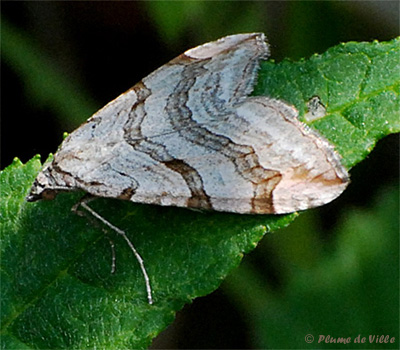
Purple(?) Treble-bar.
[Aplocera sp.
Geometridae-Larentiinae-] (Petite rayure (?) or Triple raie or
Rayure commune (?))
(?) A. praefformata. Purple Treble-bar (?) A.
plagiata Treble-bar
or St. John's Wort Inchworm.
The Treble-bar is much more common.
Both fly from May to June
(210409)
November 19th
A little grey, a little wet but mild as a spring in recent days. (8-12°
C)
Perfectly ripe and blond, they are
very tasty these seeds of the birch from the balcony.
They all compete of agility to
detach the tiny seeds that are difficult to catch and scatter to the winds when
barely touched.
Included, this catkin, I gobble it
whole!
November 23th
Encounters...
There, all down in the garden that morning, a ball of feathers puzzles
me.
It is not very visible because it's grey and gloomy.
The bird is mainly grey
with a brown tone on the back and white breast is finely streaked with dark grey
stripes.
It is a small raptor with long tails and broad rounded wings.
It is alone, or rather "she" is alone. This must be a female:
there are no red tones in the feathers of the head and chest and his nape is
dotted with white.
It is perched quietly on its big yellow legs, feathers a bit ruffled.
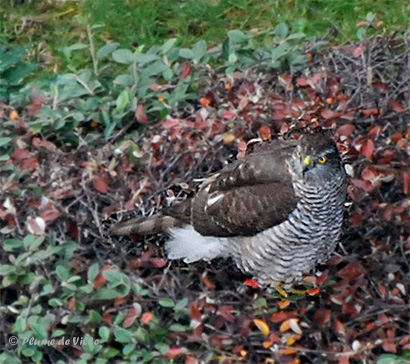
A magpie alights near its bush, and no, not by chance, it landed
straight down the bush and turned toward the raptor.
The hawk turned the heads when she alighted.
Then, as the magpie insisted, stared at it and stood there, it turned toward the magpie.
Dame pie approached frankly slowly,
watched by a hawk which fixes her
We can compare here their respective
sizes, and note that this is not a large raptor. He is 60-80 cm-wingspan for a
length of 35-40 cm, and the magpie is 52-60cm in length and 44-45cm wingspan.
The female is larger than the male.
The next moment, the magpie takes
off and... plunges directly on the hawk!
Ending prematurely my photo session.
The hawk fled.
The attack was so quick that I just
had this picture of the fan of its tail when the hawk dived under cover in a
conifer. Curiously at ground level and not flying away. But it hunts this way,
flying along the bushes. He knows how to move between branches to catch the sparrows
which are its primarily food.
Pie 1, hawk 0!
As a good guardian, the pie did not
hesitate to drive away the undesirable which did not insist. The magpie followed
it and I lost sight of the two protagonists hidden by the branches. I waited a
long time but none reappeared. The scene happened silently.
A last one.
Long tail with grey bars.
White nape and outstanding white
eyebrow.
Truly poor
pictures; the conditions were difficult. The birds where far
(40m) and the lighting low. The
magpie just gave me 40 seconds for my first Eurasian sparrowhawk.
A nest
was discovered not too far away then I hope to see it again. But
the hawk, next time, find a better perch!
(Paris-Ph. 151109)
A few days earlier I had seen a crow chase a bird
of prey over the same garden. I could not identify which it was. The little bird
of prey flied straight ahead, chased by crows which harassed him, trying to get
over him and happened to prick from time to time. Perhaps this was also the
hawk. The best eternal enemy, crows and magpies, seems to find here a common
ground!
November 24th
"A long-legged Heron, with long neck and beak,
Set out for a stroll by the bank of a creek.
So clear was the water that if you looked sharp
You could see the pike caper around with the carp..." ("The Heron Who Was Hard To Please", Jean de la Fontaine).
Two long beaks and two long necks.
Great Egret [Ardea alba, Ardeidae-Pelecaniformes](Grande aigrette) all in white
and grey heron [Ardea cinerea] (héron
cendré).
The Great Egret is the largest heron, a little
larger than the grey heron.
His long feathers that fall from its shoulders
and that nearly caused its disappearance are present only during the breeding
season.
Piscivorous, it was persecuted for his fondness
for fish. It also catches frogs, insects and even small rodents. Because of its
beautiful feathers and his regime, it has almost disappeared.
It is now protected in France and its
population has increased.
It is a winterer and also migratory in
South-Eastern Europe but rare in Western Europe. Few nesting pairs in France.
(95-100cm, 1kg)
At this time of year she has a big
yellow beak. But during the breeding season, its beak becomes black.
The fingers of its feet are black.
It is seen quite often with the
placid heron as here.
It frequents the banks of lakes,
ponds and wet meadows.
It is all immaculate white and it can be distinguished from afar. It is
very shy and has a sharp eye.
A very nice surprise to see it. Not wishing to frighten it, afraid to be
spotted, I did not move too near, I took these pictures from afar (with a 300
mm), hence the very poor quality.
I would so love to be able to approach closer. After a few slow steps in
the meadow, she flew off with big flapping of wings and got lost in the trees.
The Gray Heron stayed alone, undisturbed.
It's already great to have seen, "Get what you can, and trust for the rest; The whole is oft lost by seeking the best. Above all things beware of disdain; Where, at most, you have little to gain..." ("The Heron Who Was Hard To Please", Jean de la Fontaine)..
(Seine-et-Marne 091109)
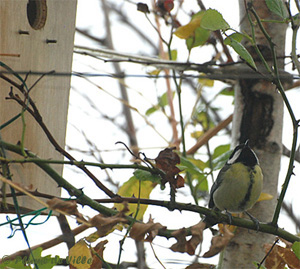 Always a spring mildness. Gray and rainy these past few days. The pair
of great tits and the blue tit (now one) which accompanies them, continue to
attend the balcony. For some time the feeders are full even if the weather not
really cold.
Always a spring mildness. Gray and rainy these past few days. The pair
of great tits and the blue tit (now one) which accompanies them, continue to
attend the balcony. For some time the feeders are full even if the weather not
really cold.
The blue tit is somewhat shy and likes to nibble on the hips of the climbing
rose.
The great tits have no such shyness and approach closely, the balcony is theirs.
We know their arrival, each bird sings when it comes.
November 27th
Gray, mildness (10° C), rain and sun
in the program.
Sprout of mushroom in the birch. I
can not tell you what species; I do not know enough mushrooms even though I
love them ... anyway, not enough to make a dish. The floor is strewn with birch
seeds.
The crocuses grow visibly. The
clematis bud.
And the hibiscus still blooms.
Red admiral. [Vanessa atalanta] (Vulcain)
In early November several fresh Red admirals, still got another orgy of
nectar from the last dahlias. They are gathering forces before going further
south.
They were
so beautiful on the flowers that I could not resist to show you them.
